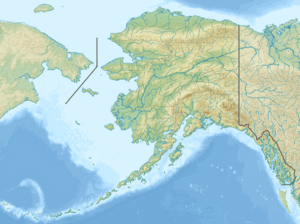Bluestone River (Alaska) facts for kids
Quick facts for kids Bluestone River |
|
|---|---|
|
Location of the mouth of the Bluestone River in Alaska
|
|
| Country | United States |
| State | Alaska |
| District | Nome Census Area |
| Physical characteristics | |
| Main source | Confluence of Gold Run and Right Fork Bluestone River Seward Peninsula 219 ft (67 m) 65°05′19″N 166°13′11″W / 65.08861°N 166.21972°W |
| River mouth | Tuksuk Channel 12 miles (19 km) southeast of Teller 0 ft (0 m) 65°11′11″N 166°01′18″W / 65.18639°N 166.02167°W |
| Length | 13 mi (21 km) |
The Bluestone River is a cool waterway found in Alaska, a state in the United States. It flows north on the Seward Peninsula. This river joins the Tuksuk Channel and is located about 11 miles (18 km) southeast of a town called Teller. A person named Edward Chester Barnard from the United States Geological Survey gave the river its name in 1900.
Contents
History of the Bluestone River Area
Gold Discovery and Early Settlements
In the early summer of 1900, something exciting happened: gold was discovered near the Bluestone River! This led to many people starting to mine for gold. Gold was found in places like Gold Run, Alder Creek, and Bering Creek.
A mining area called the Bluestone Placer Mine was set up about 15 miles (24 km) south of the U.S. government's Teller Reindeer Station. This station had been there for about eight years.
New towns quickly grew near Port Clarence. The biggest town was Teller, which by the fall of 1900 had a post office and about 1,000 people. The Bluestone gold mines were about 18 miles (29 km) from Teller. The path between them was quite difficult to walk.
Another town on Port Clarence was Bering City. It was closer to the Bluestone mines, only 12 miles (19 km) away. However, it was much smaller than Teller.
Modern Mining Activities
Even after all those years, people have continued to find gold in the Bluestone River. Since 1969, placer mining has been noted in several spots along the river. Placer mining is a way to find gold in riverbeds.
Geography of the Bluestone River
River's Origin and Flow
The Bluestone River starts in a valley. This starting point is called its "headwaters." From there, it drains water from the area between Grantley Harbor and the Bering Sea. This whole area is known as the Bluestone region.
The river's path is located between the Kigluaik Mountains and Port Clarence. The land here has flat-topped hills. For about 10 miles (16 km) before the river reaches its mouth, the Bluestone River flows through a rolling plateau. This plateau is about 400 to 600 feet (120 to 180 m) high.
River Valley Features
In this section, the river valley is wide, with flat areas next to the river called flood plains. These flood plains are at least 0.5 miles (0.8 km) wide. Further up the river, the valley changes. It becomes a steep-sided canyon with flat-topped mountains that are about 1,200 feet (370 m) tall.
The river drops about 30 feet (9.1 m) for every mile it flows. This is called its average gradient. Where the river valley gets wider, it splits into two main branches instead of just spreading out.
River Branches
The eastern branch of the Bluestone River is called Gold Run. It is about 20 miles (32 km) long and has a winding path. It first goes northwest, then turns to flow east–west. Alder Creek is a short tributary, about 2 miles (3.2 km) long, that flows into Gold Run from the east.
The western branch is known as Right Fork. It also has a winding path, flowing westward before turning east where it meets Gold Run. Right Fork also has several smaller streams that flow into it.
Geology of the Bluestone River Basin
Rock Formations and Minerals
The rocks found in the Bluestone River basin are mostly a type of rock called metapelitic sequence. You can also find mafic intrusive rocks in areas where the rocks have been changed by heat and pressure. This process is called metamorphism.
The Bluestone basin has mica and chlorite schists. These are types of metamorphic rocks. There are also layers of limestone and mafic rocks that have changed into greenstone. Small quartz veins are also common, especially in Gold Run Creek.
Some areas have minerals that show the rocks were formed under high pressure and low temperature, known as blueschist facies. Other areas show signs of later changes, called retrograde greenschist facies. Scientists believe these rock formations are from the Paleozoic Era, which was a very long time ago.
Gold and Other Metals
Gold has been found in the river's main channel and on higher areas called benches. This gold was often very fine-grained, like tiny specks. But some larger pieces, called nuggets, were also found!
The gravel where gold was found also contained other interesting minerals. These included cinnabar and platinum-group metals. Gold was also discovered in a mining spot on Skookum Creek, which is another tributary.


